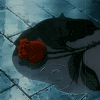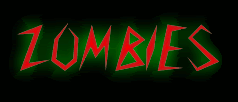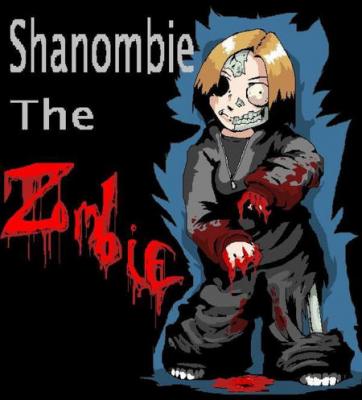If you are using Chrome, click the red hand button at the top right of the screen:

Then select: Don't run on pages on this site
If you do it correctly, the red hand will turn to green and you will no longer see this message.
 |

|
 Portfolio |  Journal |
 Bite Ashesofruin |
 Stalk Ashesofruin |
This is the sound of the lost the beat of the broken



A place where the normal minded die in the fog of my imagination.


I am known by many names, Zombie, Shanombie, Pin-Up Zombie, but you may adress me as Ashes.
--Spider-man 3, Resident Evil 3, X-men 3, Alien 3 = Such large piles of Shit that My eyes began to gush blood during the viewing of each.


Where does the name Ashes of Ruin come from? I am an addict to the world of agressive metal, my name comes from a mixture of Lamb Of God's Ashes of the Wake CD title and their song Ruin.
--Coca-cola has been given a cute nickname by myself, Loogie-Juice, for everytime I drink it my mouth is forced to produce mutant loogies that have the power to clean car batteries.


Currently I reside in the Mighty Hot state of Arizona.
-I am crazy head over heels for my current play thing.


I come to VR for intellegent Coversation and Friends, not to be asked for nude shots or to be hit on over the internet. So Please, take such things else where.
-I am in a wonderful Coven that is full of amazing people, I cherish every one of them.


My favorite Color is Purple...Just plain old Purple.
-I watch a fair amount of TV, mostly Crime shows or the Food Network (Iron Chef America!!).
--I can honestly say I have probably seen more movies than the normal human. It was all I did at one point, there are some horrid films out there.
---Music=Life, without it there is no reason for survival...beyond Sushi.


I doubt I will ever have the heart to part with my first/only car SITH. If I do, it is the end of the world, so bend over and kiss your ass goodbye.
-I am an advid reader, the written word is my drug.
--I dabble in drawing, some say I am quite talented but I find my work to be full of flaws.


I am BLUNT, very much so. If you get offended by my Sarcasticly Blunt comments I'll pay for the razor blade and even find you a dark corner to weep in over it. Opinions are Opinions, there's no reason to become hurt over something said online. Like the old saying goes: "Winning an argument online is like winning the Special Olympics, you won but you're still Retarded."

Vampires are mythological or folkloric beings that are renowned for subsisting on human blood or lifeforce, but in some cases may prey on animals. Although vampires have different characteristics depending on which lore one reads, in most cases, they are described as reanimated corpses who feed by draining and consuming the blood of living beings.
The term was popularised in the early 18th century and arose from the folklore of southeastern Europe, particularly the Balkans and Greece.[1] Folkloric vampires were depicted as undead beings who visited loved ones and caused mischief or deaths in the neighbourhoods they inhabited while living. They wore shrouds, did not bear fangs and were often described as bloated and of ruddy or darkened countenance.
The charismatic and sophisticated vampire of modern fiction was born in 1819 with the publication of The Vampyre (1819) by John Polidori. Byron's own wild life became the model for Polidori's undead protagonist Lord Ruthven. The story was highly successful and the most influential vampire work of the early 19th century.[2] However it is the 1897 novel Dracula which is best remembered as the quintessential vampire novel. The success of this book spawned a distinctive vampire genre, still popular in the 21st century. Though books and films of the genre have portrayed vampires with attributes markedly distinct from those of original folkloric vampires, some folkloric traits such as aversion to garlic and vulnerability to staking have been simply incorporated.
Numerous cultures the world over have similar entities that suck blood or energy and prey on the living; indeed, some also have stories of non-human vampires, including real animals such as bats, dogs, spiders and mythical creatures and cryptids such as the chupacabra. Vampire lore stems from ancient demonology, which had vampiric beings, but are not classified as vampires.
- -ETYMOLOGY- -
The word Vampire appeared in the Oxford English Dictionary in 1734 as much was appearing in German literature on the subject. After the 1718 Treaty of Passarowitz where parts of Serbia and Wallachia came under Austrian control, the Austrian officials noted the local practice of exhuming bodies and "killing vampires". These reports prepared between 1725 and 1732 received widespread publicity.[3] The etymology is uncertain, though several theories of its origin exist.[4] The English term was derived (possibly via French vampyre) from the German Vampir, in turn thought to be derived in the early 18th century[5] from Serbian вампир/vampir,[6][7][8][9] or Hungarian vámpír.[10][11] The Serbian and Hungarian forms have parallels in virtually all Slavic languages: Bulgarian вампир (vampir), Czech and Slovak upír, Polish wąpierz and (perhaps East Slavic-influenced) upiór, Russian упырь (upyr'), Belarusian упыр (upyr), Ukrainian упирь (upir'), from Old Russian упирь (upir'). (Note that many of these languages have also borrowed forms such as "vampir/wampir" secondarily from the West). Among the proposed proto-Slavic forms are *ǫpyrь and *ǫpirь.[12] The Slavic word might, like its possible cognate that means "bat" (Czech netopýr, Slovak netopier, Polish nietoperz, Russian нетопырь / netopyr' - a species of bat), contain a Proto-Indo-European root for "to fly".[12]
The first recorded use of the Old Russian form Упирь (Upir') is commonly believed to be in a document dated 6555 (1047 AD). It is a colophon in a manuscript of the Book of Psalms written by a priest who transcribed the book from Glagolitic into Cyrillic for the Novgorodian Prince Vladimir Yaroslavovich. The priest writes that his name is "Upir' Likhyi " (Упирь Лихый), which would mean something like "Wicked Vampire"or "Foul Vampire." This apparently strange name has been cited as an example of surviving paganism and/or of the use of nicknames as personal names. However, in 1982, Swedish Slavicist Anders Sjöberg suggested that "Upir' likhyi" was in fact an Old Russian transcription and/or translation of the name of Öpir Ofeigr, a well-known Swedish rune carver. Sjöberg argued that Öpir could possibly have lived in Novgorod before moving to Sweden, considering the connection between Eastern Scandinavia and Russia at the time. This theory is still controversial, although at least one Swedish historian, Henrik Janson, has expressed support for it. Another early use of the Old Russian word is in the anti-pagan treatise "Word of Saint Grigoriy," dated variously to the 11th—13th centuries, where pagan worship of upyri is reported.
- -FOLK BELIEFS- -
The notion of vampirism has been in use for millennia; cultures such as the Mesopotamians, Hebrews, Ancient Greeks, and Romans had tales of demons and spirits including the Empusa, Lamia, and Lilitu, who would eat flesh and drink blood; even the devil was considered synonymous with the vampire in earlier times. However, despite the occurrence of vampire-like creatures in these ancient civilizations, the mythology for the entity we know today as the vampire comes almost exclusively from Southeastern Europe. In most cases, vampires are revenants of evil beings, suicide victims or witches, but can also be created by a malevolent spirit possessing a corpse or by being bitten by a vampire itself. The legends of the vampire grew to such a height, that in some areas it caused mass hysteria and even public executions of people believed to be vampires. Although the original lore has been distorted due to new fictional references such as Dracula, there are many ways to destroy a vampire; decapitation, a stake to the heart, incineration and exposure to sunlight are commonly cited.
- -DESCRIPTION/COMMON ATTRIBUTES- -
It is difficult to make a single, definitive description of the folkloric vampire though there are several elements common to many European legends. It is usually reported as bloated in appearance and ruddy, purplish or dark in colour, often attributed to drinking blood. Indeed, blood is often seen seeping from the mouth and nose when one is seen in its shroud or coffin and his left eye is often open. Clothing often consisted of the linen shroud they were buried in and teeth, hair and nails may have grown somewhat, though in general fangs were not a feature.
Other attributes may vary greatly from culture to culture; some vampires, such as those found in Transylvanian tales, are gaunt, pale and have long fingernails, while Bulgarian vampires only had one nostril, while Bavarian vampires slept with thumbs crossed and one eye open. Moravian vampires only attacked victims naked and the vampires of Albanian folklore wore high heeled shoes. As stories of vampires spread throughout the globe to the Americas and elsewhere, so did the varied and sometimes bizarre descriptions of them; Mexican vampires have a bare skull instead of a head, Brazilian vampires had furry feet and vampires from the Rocky Mountains only sucked blood with their noses from the victim's ears. Even broad descriptions were implemented, such as having red hair. So from these various descriptions across time, works of literature such as Bram Stoker's Dracula and the influences of historical figures such as Gilles de Rais and Vlad Tepes, the vampire has developed into the stereotype we perceive today; over time, a selection of more common reported attributes from a huge variety of ancient and medieval stories have coalesced to form a contemporary vampire profile as seen in literature and film today.
- -CREATION- -
It is commonly accepted in modern cultural depictions that one is likely to become a vampire if bitten by one. However the causes were far more varied in original vampire folklore. In Slavic and also Chinese traditions any corpse which was jumped over by an animal, particularly a dog or cat, would become one of the undead.[30] If a body had a wound which had not been treated with boiling water. And in Russian mythology, vampires were said to have once been witches while they were living, or people who rebelled against the church. [29]
Practices often arose that were intended to prevent a recently deceased loved one turning into an undead revenant. Burying a corpse upside-down was a common prevention method, as well as placing earthly objects, such as scythes or sickles, near the grave to satisfy any demons entering the body or to appease the dead so that it would not wish to arise from its coffin. This method is similar to the ancient Greek practice of placing a obolus in the corpse's mouth so that they may pay their way across the River Styx in the underworld; it has been argued that instead, the obolus was intended to ward off any evil spirits from entering the body and this may have influenced later mythology surrounding the vampire. This Greek tradition was continued on in regard to modern Greek folklore about the vrykolakas, the equivalent of a modern vampire, in which a wax cross and piece of pottery with the inscription "Jesus Christ conquers" were placed on the corpse to prevent the body becoming a vrykolakas. Other methods commonly practised in Europe included severing the tendons at the knees or placing poppy seeds, millet or sand on the ground at the gravesite of a presumed vampire; this was intended to keep the vampire occupied all night by counting the fallen grains. In similar Chinese narratives about vampire-like beings, it is stated that if one of these creatures comes across a sack of rice, he will have to count all of the grains; this is a theme similar to myths recorded on the Indian subcontinent as well as in South American tales of witches and other sorts of evil or mischievous spirits or beings.
- -VAMP ID- -
The rituals behind identifying a vampire were in most cases elaborate, with several methods arising throughout Eastern Europe and other areas where vampire legends became prominent. In some Eastern European instances, the method of finding a vampire's grave involved leading a virgin boy through a graveyard or church grounds on a virgin, black stallion; the tomb which the horse stopped at first was said to be that of the vampire's. Corpses thought to be vampires were generally described as having a healthier appearance than expected, plump and showing little or no signs of decomposition. In some cases, when suspected graves were opened, villagers even described the corpse as having fresh blood from a victim all over its face, although many theories have been made attributing all these abnormal appearances to natural causes and village hysteria; Some historians have stated that the coffin acted as an airtight tomb in some cases, thus preserving the body from decomposition, much in the same way as natural mummies are preserved. However, when the villagers open the coffin in search of a vampire, the rate of decomposition is accelerated rapidly by the change of pressure and air, so much so that it may appear to be evaporating significantly; in most legends of vampires, when a vampire is stabbed in the heart with a wooden stake, it is said to deteriorate into nothing more than a skeleton, propagating this theory further. Another modern theory attempting to debunk the appearance of undecomposed corpses in coffins is the fact that the person could have simply been buried alive. Evidence that a vampire was active in a given locality included death of cattle, sheep, relatives or neighbours; folkloric vampires could also make their presence felt by engaging in minor poltergeist-like activity and pressing on people in their sleep.
- -PROTECTION- -
A common theme is the use of apotropaics to ward the revenants off, namely mundane or sacred items or things such as garlic, sunlight or holy water. Items vary from region to region; a branch of wild rose is said to harm vampires as well as the hawthorn plant; in Europe, sprinkling mustard seeds on the roof of a house was said to keep vampires away. Other apotropaics include sacred items, for example a crucifix, rosary beads and the aforementioned holy water; vampires are said to be unable to walk on consecrated ground, such as those of churches or temples or cross running water. In Asian legends, vampiric creatures are often warded by holy devices such as Shintō seals. In South American superstition, Aloe vera hung backwards behind or near a door has the same function. Although not regarded as a vampire apotropaic, mirrors have been used to ward off vampires when placed facing outwards on a door; it's a well known myth that vampires do not have a reflection and in some cultures, do not cast shadows either, perhaps to express the vampire's lack of a soul. This attribute, although not universal as the Greek vrykolakas/tympanios was capable of both reflection and shadow, was utilized by Bram Stoker in Dracula and has since remained popular with subsequent authors and filmmakers. In addition to apotropaics, some traditions hold that a vampire cannot enter a house unless invited by the owner, although they only have to be invited once as after this they can come and go as they please without further permission.
Traditional methods of destroying vampires are numerous, with the most commonly cited the driving of a wooden, or less commonly metal, stake through the heart. The preferred wood is ash in Russia and the Baltic states, or hawthorn in Serbia, with a record of oak in Silesia. This is thought to have originated in Eastern Europe along with many other vampire legends; unlike today's cloaked and suave vampires, the original revenants were described as largely bloated. Thus the act of piercing the skin of the chest was a way of "deflating" the vampire; this is similar to the act of burying sharp objects, such as sickles, in with the corpse, so that they may penetrate the skin if the body bloats sufficiently whilst transforming into a revenant. Other methods include decapitation or complete incineration of the body. Other than being decapitated, the vampire's head may also have a spike driven through it, often with force so as to pin it to the ground. The act of cutting off the head was also seen as a way of hastening the departure of the soul from the body, which in some cultures, was said to linger in the corpse for a prolonged amount of time before dispersing.
Vampires are sometimes endowed with special abilities when described in folklore; some are given great strength, while others the ability to transform not only into a bat, as is often depicted in modern cartoons and film, but rather other familiars such as rats, dogs, wolves, spiders and even moths. An attribute shared by the 19th century literary vampires Lord Ruthven and Varney the Vampire was the ability to be healed by moonlight, although no account of this is known in traditional folklore. Though folkloric vampires thought more active at night, they were not generally considered vulnerable to sunlight. This vulnerability has developed with subsequent vampire fiction.
- -ANCIENT BELIEF- -
Tales of the undead consuming the blood or flesh of living beings have been found in nearly every culture around the world for many centuries. Today we know these entities predominantly as vampires, but in ancient times, the term vampire didn't exist; blood drinking and such like was referred to as the work of demons or spirits, such as Lilith, Empusa, Lamia and other monsters; vampires and the devil were closely linked in many cultures as well. Modern vampire mythology spread from Eastern Europe, however, early vampiric creatures have been described throughout the world — from Europe to Asia, from the Americas to the Pacific. Almost every nation has associated blood drinking with some kind of revenant or demon. Indeed, some of these legends could have given rise to the Eastern European folklore, though they are not strictly considered vampires by historians when using today's definitions.








A zombie is a reanimated corpse devoid of consciousness. In contemporary versions these are generally undead corpses, which were traditionally called "ghouls". Stories of zombies originated in the Afro-Caribbean spiritual belief system of Vodou.
Other more macabre versions of zombies have become a staple of modern horror fiction, where they are brought back from the dead by supernatural or scientific means, and eat the flesh or brains of the living. They have very limited intelligence, and may not be under anyone's direct control. This type of zombie, often referred to as a Romero zombies after the filmmaker who defined the concept, is archetypal in modern media and culture.
- -VOODOO?- -
According to the tenets of Voodoo, a dead person can be revived by a bokor or Voodoo sorcerer. Zombies remain under the control of the bokor since they have no will of their own. "Zombi" is also another name of the Voodoo snake god Damballah Wedo, of Niger-Congo origin; it is akin to the Kongo word nzambi, which means "god". There also exists within the voudon tradition the zombi astral which is a human soul that is captured by a bokor and used to enhance the bokor's power.
In 1937, while researching folklore in Haiti, Zora Neale Hurston encountered the case of Felicia Felix-Mentor, who had died and been buried in 1907 at the age of 29. Villagers believed they saw Felicia wandering the streets in a daze thirty years after her death, as well as claiming the same with several other people. Hurston pursued rumors that the affected persons were given powerful drugs, but she was unable to locate individuals willing to offer much information. She wrote:
"What is more, if science ever gets to the bottom of Voodoo in Haiti and Africa, it will be found that some important medical secrets, still unknown to medical science, give it its power, rather than gestures of ceremony." [1]
Several decades later, Wade Davis, a Canadian ethnobotanist, presented a pharmacological case for zombies in two books, The Serpent and the Rainbow (1985) and Passage of Darkness: The Ethnobiology of the Haitian Zombie (1988). Davis traveled to Haiti in 1982 and, as a result of his investigations, claimed that a living person can be turned into a zombie by two special powders being entered into the blood stream (usually via a wound). The first, coup de poudre (French: 'powder strike'), induced a 'death-like' state because of tetrodotoxin (TTX), its key ingredient. Tetrodotoxin is the same lethal toxin found in the Japanese delicacy fugu, or pufferfish. At near-lethal doses (LD50= 5-8µg/kg)[2], it can leave a person in a state of near-death for several days, while the person continues to be conscious. The second powder, composed of dissociatives like datura, put the person in a zombie-like state where they seem to have no will of their own. Davis also popularized the story of Clairvius Narcisse, who was claimed to have succumbed to this practice. There remains considerable skepticism about Davis's claims,[3] although there is wide belief among the Haitian people of the existence of the "zombie drug". The Voodoon religion being somewhat secretive in its practices and codes, it can be very difficult for a foreign scientist to validate or invalidate such claims.
Others have discussed the contribution of the victim's own belief system, possibly leading to compliance with the attacker's will, causing psychogenic ("quasi-hysterical") amnesia, catatonia, or other psychological disorders, which are later misinterpreted as a return from the dead. Scottish psychiatrist R. D. Laing further highlighted the link between social and cultural expectations and compulsion, in the context of schizophrenia and other mental illness, suggesting that schizogenesis may account for some of the psychological aspects of zombification.
- -FOLKLORE- -
In the Middle Ages, it was commonly believed that the souls of the dead could return to earth and haunt the living. The belief in revenants (someone who has returned from the dead) are well documented by contemporary European writers of the time. According to the Encyclopedia of Things that Never Were, particularly in France during the Middle Ages, the revenant rises from the dead usually to avenge some crime committed against the entity, most likely a murder. The revenant usually took on the form of an emaciated corpse or skeletal human figure, and wandered around graveyards at night. The "draugr" of medieval Norse mythology were also believed to be the corpses of warriors returned from the dead to attack the living. The zombie appears in several other cultures worldwide, including China, Japan, the Pacific, India, and the Native Americans.
The Epic of Gilgamesh of ancient Sumer includes a mention of zombies. Ishtar, in the fury of vengeance says:
Father give me the Bull of Heaven,
So he can kill Gilgamesh in his dwelling.
If you do not give me the Bull of Heaven,
I will knock down the Gates of the Netherworld,
I will smash the doorposts, and leave the doors flat down,
and will let the dead go up to eat the living!
And the dead will outnumber the living!
- -PHILOSOPHY- -
In philosophy of mind, zombies are hypothetical persons who lack full consciousness but have the biology or behavior of a normal human being; thought experiments involving them are often used as arguments against the identity of the mind and the brain. The term was coined by philosopher of mind David Chalmers. They are referred to as philosophical zombies or "p-zombies".







| Member Since: | Feb 06, 2006 |
| Last Login: | Jun 18, 2009 |
| Times Viewed: | 9,254 |
| Times Rated: | 731 |
| Rating: | 9.252 |
Rated by BlackDragonKnight!